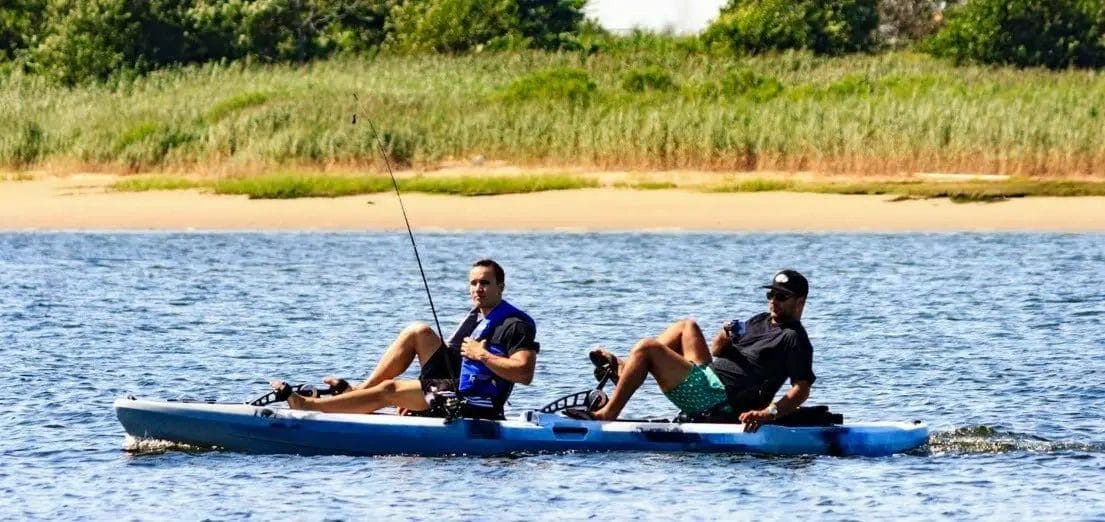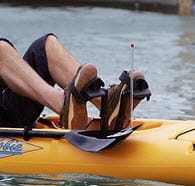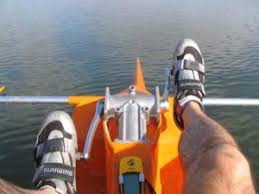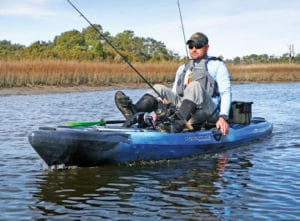The different types of pedal kayaks


Recently for fishing more than anything pedal kayaks have really been picking up speed and becoming more and more popular. There’s something about the ability to pedal and fish without having to take your hands and use a paddle that makes fishing on a kayak much easier and much more efficient.
However, with the increase in the number of pedal kayaks there has also been an increase in questions and different brands that have come out with different pedal systems.
Today we’re going to cover these pedal systems and discuss the difference between each and why you would want one over the other
If you want a list of the pedal kayaks out there be sure to check out our guide by clicking the link.
Starting up you need to know that there is a difference between rotational paddles and push pedals.
Traditionally kayak shops like native watercraft and be KC have used rotational paddles. Rotational paddles are pedals that are very similar to a bicycle that allows you to rotate and push the pedal system forward which then gives your kayak movement forward and backward. Now one of the biggest positives of rotational paddles has been the fact that they can go backward, with the advent of new pedal drives most of the pedal drives out there can now, in fact, go backward as well so this added feature is now the standard.
Rotational Pedals

Where rotational pedals really excel however is the fact that you get more energy pushed out while you’re pedaling because of the rotational movements like on a bicycle if you stop pedaling there is still a couple of seconds of that energy pushing on the water. With a bicycle that energy might go on for some time however, with the pedal kayak because of the resistance of the water you might get half a second of extra push.
That extra second could mean the difference between a couple of kilometers versus only a few when you compare it to the other systems out there.
Push Pedals

Now when we look at the push pedals which are pedal systems traditionally created by the Hobie company and used on all of their kayaks we see a stark difference. The push pedals work with you pushing in one direction against them and because your feet are strapped onto the pedals you pull back and push causing the kayak to move.
Some studies and unofficial tests have shown that these Hobie kayaks are slightly faster than rotational pedal systems however they do expend more energy than the rotational pedal system so if you are racing the Hobie the Hobie might get up in front of you. But at the end of the day when you’re looking at distance you will go farther with the rotational paddles.
Our Recommendation
It is for this distinct purpose we recommend the rotational pedal system over the push pedal system because you do use a little bit less energy expenditure and over the long run you are less worn out when peddling, and when pedal fishing you don’t really need to win the race you just need to enjoy yourself in the outdoors.
Materials
Push Pedals
Now interestingly enough there are a bunch of different materials out there for these two pedal systems when we talk about the push pedal system most of the materials are Hobie base which is reinforced with anticorrosive materials that make sure that your pedal system does not wear out over time. You can get replacement parts directly from Hobie and usually these are a little more high quality but they reflect in their price which could be up to double the cost of a pedal kayak that uses rotational paddles.
Rotational Pedals

The materials to make a rotational paddle kayak are similar to those with the push pedal a lot of these, in an aluminum-based system that is rustproof and coated with extra dust coating that allows your system to avoid any type of wear tear or rust.
Lift Up System
Most of these pedal systems have a lock-in system that puts them into your kayak when you need to take them out or when you’re launching or docking your kayak you simply lift up this pedal system and it comes out of the kayak at a certain angle allowing you to dock your kayak and then release the clamps to bring the pedal system up.
This is incredibly efficient because it takes away the worry or chance that you might scrape or break your pedal system on the bottom of the lake or ocean floor where you are using it.
Wrapping up
Whichever pedal system you use were sure you’ll be happy the differences between the two are small however if you are more price conscience I would recommend the rotational paddle system.
If you are looking for the Cadillac of pedal systems there are many that argue that the push pedal system is the best one and most technically advanced one out there from Hobie.
